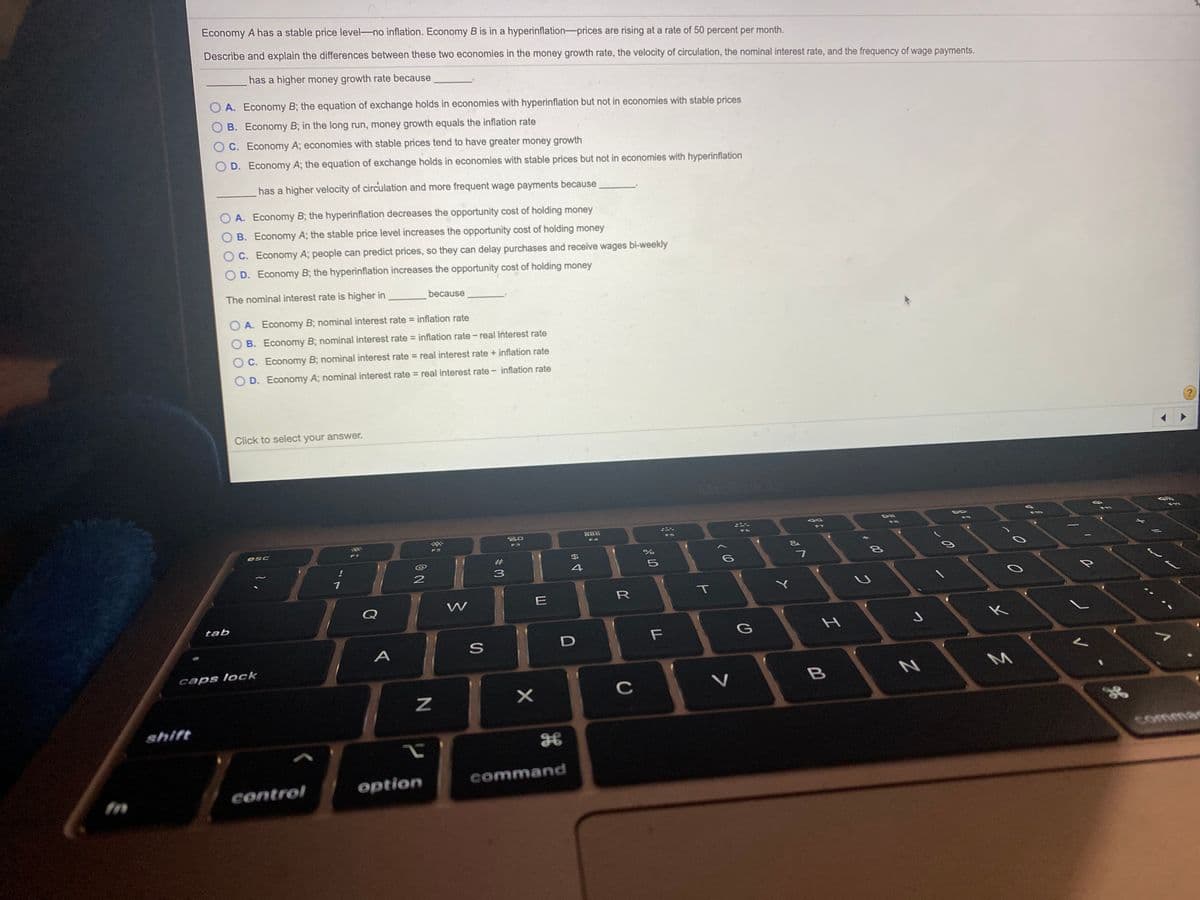Economy A has a stable price level-no inflation. Economy B is in a hypennflation-prices are nsing at rate of 50 percent per montn. Describe and explain the differences between these two economies in the money growth rate, the velocity of circulation, the nominal interest rate, and the frequency of wage payments. has a higher money growth rate because A. Economy B; the equation of exchange holds in economies with hyperinflation but not in economies with stable prices B. Economy B; in the long run, money growth equals the inflation rate OC. Economy A; economies with stable prices tend to have greater money growth OD. Economy A; the equation of exchange holds in economies with stable prices but not in economies with hyperinflation has a higher velocity of circulation and more frequent wage payments because A. Economy B, the hyperinflation decreases the opportunity cost of holding money O B. Economy A; the stable price level increases the opportunity cost of holding money OC. Economy A; people can predict prices, so they can delay purchases and receive wages bi-weekly OD. Economy B; the hyperinflation increases the opportunity cost of holding money The nominal interest rate is higher in because A. Economy B; nominal interest rate = inflation rate OB. Economy B, nominal interest rate = inflation rate-real interest rate OC. Economy B; nominal interest rate = real interest rate + inflation rate OR Economy A; nominal interest rate = real interest rate - inflation rate
Economy A has a stable price level-no inflation. Economy B is in a hypennflation-prices are nsing at rate of 50 percent per montn. Describe and explain the differences between these two economies in the money growth rate, the velocity of circulation, the nominal interest rate, and the frequency of wage payments. has a higher money growth rate because A. Economy B; the equation of exchange holds in economies with hyperinflation but not in economies with stable prices B. Economy B; in the long run, money growth equals the inflation rate OC. Economy A; economies with stable prices tend to have greater money growth OD. Economy A; the equation of exchange holds in economies with stable prices but not in economies with hyperinflation has a higher velocity of circulation and more frequent wage payments because A. Economy B, the hyperinflation decreases the opportunity cost of holding money O B. Economy A; the stable price level increases the opportunity cost of holding money OC. Economy A; people can predict prices, so they can delay purchases and receive wages bi-weekly OD. Economy B; the hyperinflation increases the opportunity cost of holding money The nominal interest rate is higher in because A. Economy B; nominal interest rate = inflation rate OB. Economy B, nominal interest rate = inflation rate-real interest rate OC. Economy B; nominal interest rate = real interest rate + inflation rate OR Economy A; nominal interest rate = real interest rate - inflation rate
Chapter1: Making Economics Decisions
Section: Chapter Questions
Problem 1QTC
Related questions
Question

Transcribed Image Text:Economy A has a stable price level-no inflation. Economy B is in a hyperinflation-prices are rising at a rate of 50 percent per month.
Describe and explain the differences between these two economies in the money growth rate, the velocity of circulation, the nominal interest rate, and the frequency of wage payments.
has a higher money growth rate because
O A. Economy B; the equation of exchange holds in economies with hyperinflation but not in economies with stable prices
B. Economy B; in the long run, money growth equals the inflation rate
C. Economy A; economies with stable prices tend to have greater money growth
O D. Economy A; the equation of exchange holds in economies with stable prices but not in economies with hyperinflation
has a higher velocity of circulation and more frequent wage payments because,
A. Economy B; the hyperinflation decreases the opportunity cost of holding money
B. Economy A; the stable price level increases the opportunity cost of holding money
O C. Economy A; people can predict prices, so they can delay purchases and receive wages bi-weekly
O D. Economy B; the hyperinflation increases the opportunity cost of holding money
The nominal interest rate is higher in
because
O A. Economy B; nominal interest rate = inflation rate
O B. Economy B; nominal interest rate inflation rate- real interest rate
%3D
O C. Economy B; nominal interest rate = real interest rate + inflation rate
O D. Economy A; nominal interest rate = real interest rate - inflation rate
Click to select your answer.
888
F4
F3
F2
%23
$4
4
5
2
R
T
Q
W
tab
K
F
G
H
A
caps lock
C
B
shift
comma
option
command
control
Expert Solution
This question has been solved!
Explore an expertly crafted, step-by-step solution for a thorough understanding of key concepts.
This is a popular solution!
Trending now
This is a popular solution!
Step by step
Solved in 3 steps with 1 images

Knowledge Booster
Learn more about
Need a deep-dive on the concept behind this application? Look no further. Learn more about this topic, economics and related others by exploring similar questions and additional content below.Recommended textbooks for you


Principles of Economics (12th Edition)
Economics
ISBN:
9780134078779
Author:
Karl E. Case, Ray C. Fair, Sharon E. Oster
Publisher:
PEARSON

Engineering Economy (17th Edition)
Economics
ISBN:
9780134870069
Author:
William G. Sullivan, Elin M. Wicks, C. Patrick Koelling
Publisher:
PEARSON


Principles of Economics (12th Edition)
Economics
ISBN:
9780134078779
Author:
Karl E. Case, Ray C. Fair, Sharon E. Oster
Publisher:
PEARSON

Engineering Economy (17th Edition)
Economics
ISBN:
9780134870069
Author:
William G. Sullivan, Elin M. Wicks, C. Patrick Koelling
Publisher:
PEARSON

Principles of Economics (MindTap Course List)
Economics
ISBN:
9781305585126
Author:
N. Gregory Mankiw
Publisher:
Cengage Learning

Managerial Economics: A Problem Solving Approach
Economics
ISBN:
9781337106665
Author:
Luke M. Froeb, Brian T. McCann, Michael R. Ward, Mike Shor
Publisher:
Cengage Learning

Managerial Economics & Business Strategy (Mcgraw-…
Economics
ISBN:
9781259290619
Author:
Michael Baye, Jeff Prince
Publisher:
McGraw-Hill Education